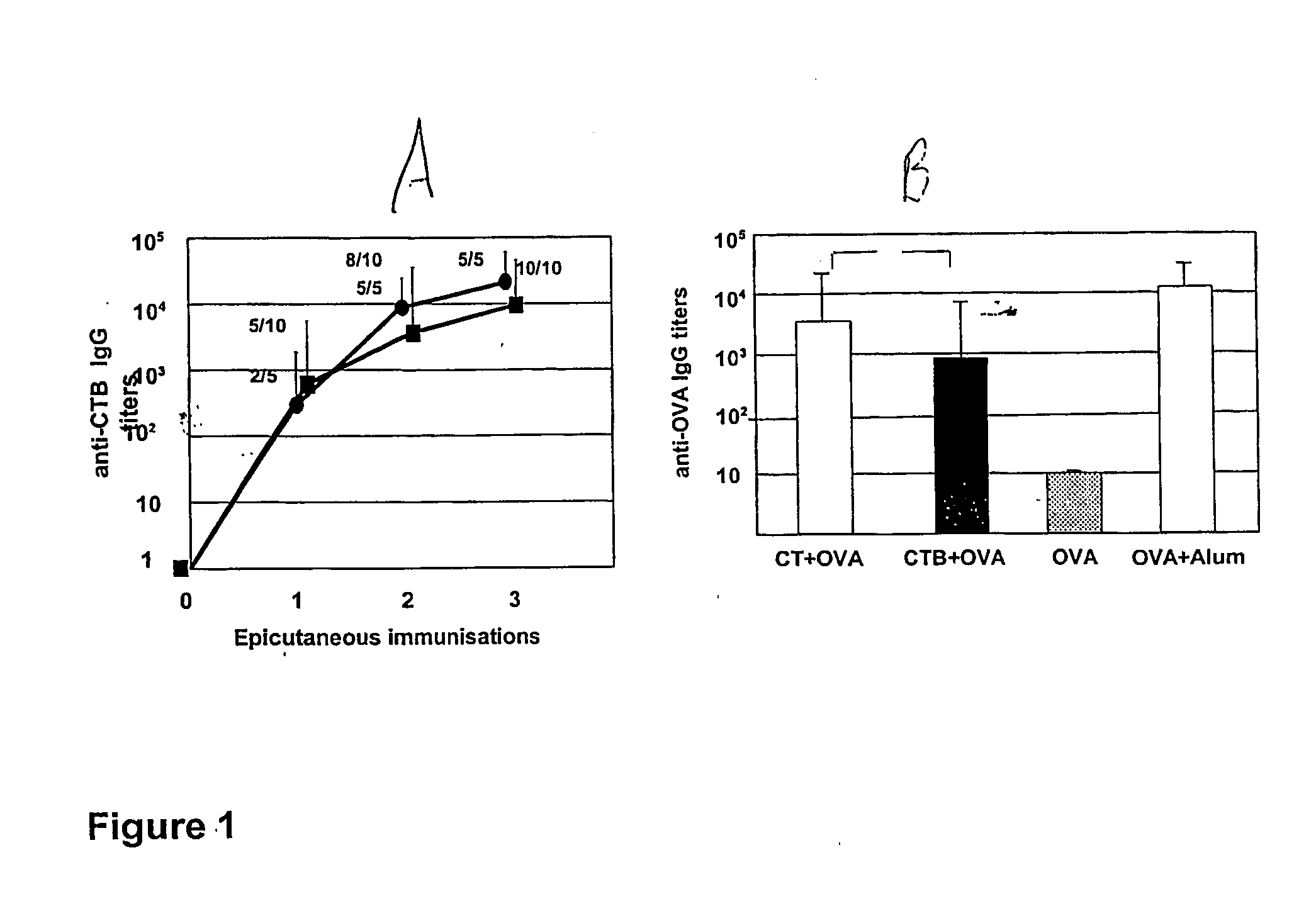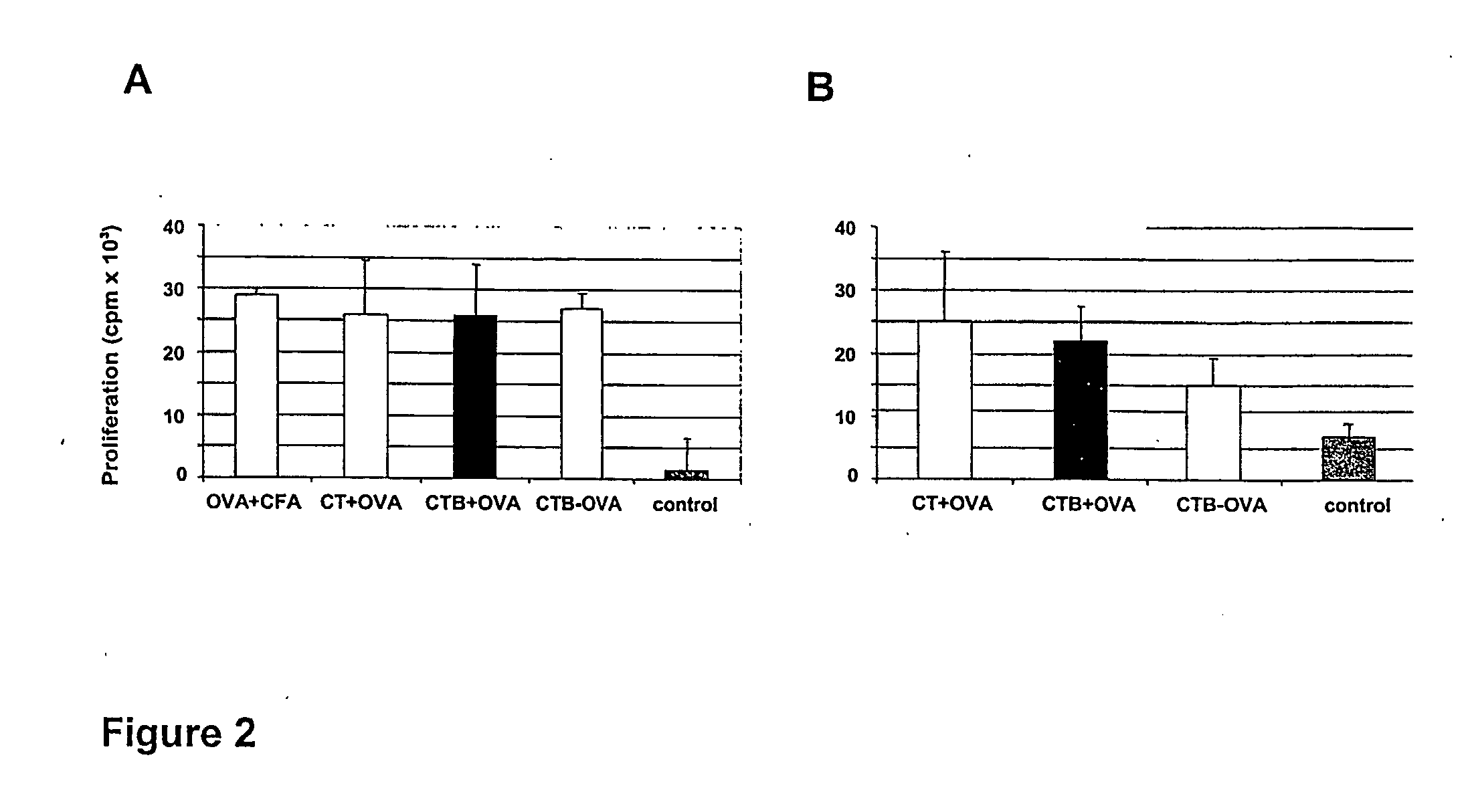Supression of allergic reactions by transdermal administration of allergens conjugated to cholera toxin or fragments thereof
a technology of cholera toxin and transdermal administration, which is applied in the direction of allergen ingredients, bacterial antigen ingredients, non-active ingredients of pharmaceuticals, etc., can solve the problems of life-threatening anaphylaxis, sudden reaction, severe reaction, etc., and achieve the effect of suppressing an ige-mediated allergic reaction and suppressing the allergic reaction
- Summary
- Abstract
- Description
- Claims
- Application Information
AI Technical Summary
Benefits of technology
Problems solved by technology
Method used
Image
Examples
example 1
Both CT and CTB Transcutaneously Induce Strong Serum Antibody Responses Against Themselves
[0144] When given topically onto the skin, CTB was bound to be as efficient as CT to induce the production of specific antibodies to itself (FIG. 1A). After three epicutaneous treatments, all mice had responded with anti-CTB antibody titers at or above 10,000.
example 2
CTB is Less Efficient than CT in Promoting a Systemic Antibody Response to Co-Administered OVA
[0145] The ability of CTB, as compared to CT, to promote systemic antibody responses to a prototype co-administered antigen (OVA) was evaluated. As shown in FIG. 1B, the topical application of OVA with CTB led to the production of significant anti-OVA IgG (geometric mean titer=720) whereas OVA administered onto skin was not able to induce the production of IgG against itself (titers at or below 10). However, the magnitude of the anti-OVA response induced by OVA co-administered with CTB was fivefold lower than that evoked by OVA together with CT (geometric mean titer=3500) (FIG. 1B). Even so, also the latter levels of anti-OVA specific antibodies were lower than the level induced by an i.p. injection of OVA in alum (FIG. 1B).
example 3
Co-Administration of Either CT or CTB with OVA Leads to Vigorous OVA-Specific T Cell Proliferative Responses Both in Draining Lymph Nodes and at Distant Systemic Sites
[0146] The specific proliferative responses in cells from lymph nodes draining the epicutaneous site of immunization (DLN) and from the spleen was evaluated. For this, the OVA-induced proliferation of such cells was measured during in vitro restimulation with 2 mg / ml OVA after three consecutive epicutaneous immunizations.
[0147] Topical application of OVA with CT or CTB led to the generation of similarly strong anti-OVA proliferative responses in DLN cells (FIG. 2A). These responses were specific for OVA as indicated by the lack of any in vitro response to an unrelated protein antigen, LACK (not shown). Interestingly, epicutaneous treatments with OVA and CT or CTB were as efficient in inducing anti-OVA proliferative responses as subcutaneous injection of OVA in CFA, a treatment known to be very potent in inducing cell...
PUM
| Property | Measurement | Unit |
|---|---|---|
| Magnetic field | aaaaa | aaaaa |
| Volume | aaaaa | aaaaa |
| Fraction | aaaaa | aaaaa |
Abstract
Description
Claims
Application Information
 Login to View More
Login to View More - R&D
- Intellectual Property
- Life Sciences
- Materials
- Tech Scout
- Unparalleled Data Quality
- Higher Quality Content
- 60% Fewer Hallucinations
Browse by: Latest US Patents, China's latest patents, Technical Efficacy Thesaurus, Application Domain, Technology Topic, Popular Technical Reports.
© 2025 PatSnap. All rights reserved.Legal|Privacy policy|Modern Slavery Act Transparency Statement|Sitemap|About US| Contact US: help@patsnap.com



